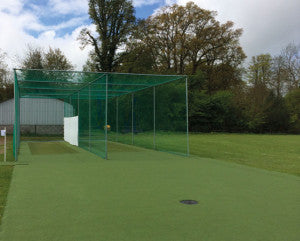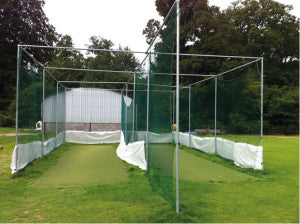Cricket - End of season health-check...

Non-turf systems: repair, replace or re-vamp?
Modern non-turf cricket pitch systems (NTPs) have been designed to require minimal maintenance between seasons so, if you have a state-of-the-art system, you're unlikely to need to do much beyond (in the case of practice facilities) checking nets and either lifting them off the surface or removing them for repair and/or storage. In this case, for both match and practice facilities, clearing debris off the carpet and giving it a good clean before the new season starts should see you with a play-ready facility.
However, while older NTPs are certainly low maintenance, it doesn't mean that they require no attention. The end of the playing season is the time to carry out a series of tasks that could help extend their lifespan, including:
- Clearing surfaces of any leaf litter and / or water damage
- Checking carpets for damage requiring repair
- Reviewing batting curtains and nets
- Re-marking crease lines
- Removing and storing nets for winter (practice facilities only)
- Weedkilling playing surfaces
- Sweeping surfaces to agitate carpet pile and ensure maximum traction
- Installing leaf debris netting (practice facilities only)
- Installing pest control PVC or mesh skirting (practice facilities only)

If there are significant signs of wear and tear, a complete new system may not be the only answer - refurbishment and restoration of existing facilities are becoming increasingly popular options that can fit with your budget and needs. From replacing system components to converting open-ended systems into a fully enclosed practice facilities or upgrading to an ECB approved playing surface, there are numerous options available.
Fine turf tables - beyond end of season works
In the case of natural playing surfaces, most of you will be well-versed in the end of season processes - however, now is the time to mull over the following questions:
- Is the table the right size for the level of play?
- Are there any niggling issues - thatch build-up, compaction, uneven surface levels, standing water, poor grass coverage - even profile layering?
- Poor performance - i.e. low bounce
If the table falls short in terms of either size or quality, now is the time to consider remedial works and call in the experts to discuss your options. Traditionally, issues such as severe unlevel surfaces, saddling and profile layering would have meant reconstructing the table from scratch. Now, however, there are options that can help alleviate some - if not all - of these issues for a fraction of the work, cost and 'down time'; and can even enable the existing table to be extended using a mixture of on-site and imported materials with minimum disruption.
Our 'Framework for Natural Cricket Tables' defines four key processes that prescribe works of various levels designed to breathe life back into tired surfaces, which we have successfully implemented at a number of clubs across the country:
End of Season Renovation. Works, include scarification, over-seeding, top dressing and the application of fertiliser, help to ensure pitches recover and are back to playing standard in time for the following season.
Table Construction. Whether 'Full Construction', which incorporates a gravel raft, building layer and loam, or 'Profile Construction', which uses imported loam directly on the existing soil base, this requires in-depth site analysis, sourcing of imported materials, construction ground works and the provision of a maintenance programme for the new table during its 12-18 month establishment period.
Square Restoration is used to rectify the most commonly seen faults in an established square; such as saddling, an undesirable thatch layer, uneven surface levels and poor grass coverage. It can also be used to incorporate a new loam to help boost the growth of a sward well suited to cricket, but is limited in terms of the severity of issues it can solve.
Profile Regeneration. This process has been designed to bridge the gap between surface works and pitch construction. It is a hybrid of the two, and should be viewed as 'going a stage further' than the restoration process. Where conditions allow, it acts as a cost-effective alternative to construction as it can solve many of the same problems; such as severe issues with levels and profile layering. Regeneration also results in an immediate improvement to performance and will enable the square to be used the following season, thus avoiding the delays often associated with construction works. It is, however, restricted to a depth of 80-100 mm.
To discuss how total-play could support you in the maintenance or renovation of your non-turf or natural cricket facility; from offering advice on maintenance programmes to carrying out works through its in-house grounds team, contact 01604 864 575 or visit www.total-play.co.uk
Before establishing total-play Ltd, MD David Bates' career included spells as Head Groundsman at Northamptonshire CCC, Chairman of the First Class Grounds Committee and a trainer and pitch advisor for both the IoG and ECB. The company was the first to be awarded ECB (England & Wales Cricket Board) Code of Practice status for non-turf pitches; having met all criteria of the ECB's 'Code of Practice for the Design and Installation of Non-Turf Cricket Facilities'. It has gone on to develop a range of synthetic match and practice carpet systems; including its flagship tp365 ECB approved design.
